Explore the Gastronomic Delights of Spanish Ham:
Jamón Ibérico, Jamón Serrano, and Gran Reservas
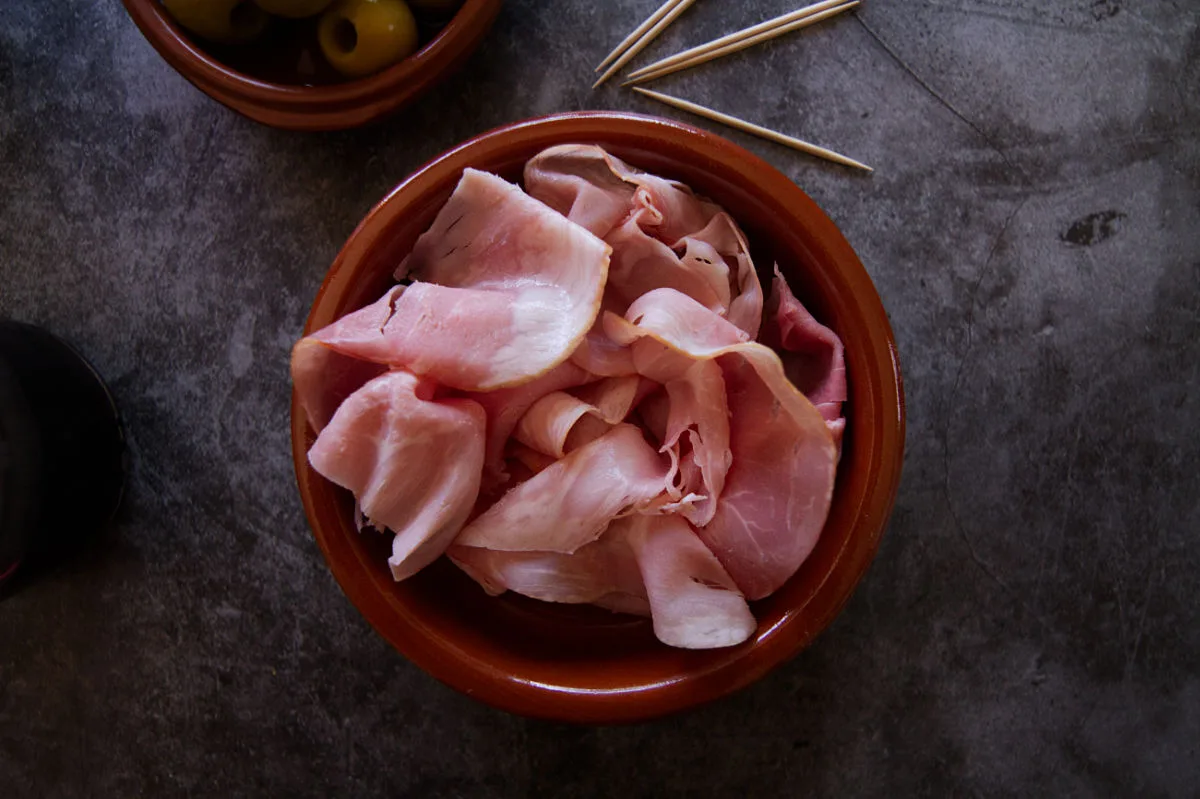
Discover Spanish Ham
Explore the gastronomic delights of Spanish Ham: Jamón Ibérico, Jamón Serrano, and what makes a Gran Reserva. Each slice of Spanish ham tells a story of generations dedicated to preserving a culinary heritage that marries gastronomic tradition with innovation.
From the world-renowned Jamón Ibérico, born from the noble lineage of Iberian pigs and their acorn-fed diet; to the equally cherished Jamón Serrano, carefully crafted from the robust white mountain pig breed; to the exquisite Gran Reservas, aged to perfection — these hams reflect the nation’s profound respect for flavors, techniques, and the essence of sharing a meal.
Discover the different types of Spanish ham, including identifying the key differences between Jamón Ibérico, Jamón Serrano, and what makes a Gran Reserva. We’ll also look at how each type of Spanish ham is made, where to buy good quality Spanish ham, plus offer a few recipes, and answer the most frequently asked questions relating to Spanish ham.
This post may contains affiliate links for products that we use and love.
Table of contents:
- Is Spanish Ham the Best Ham in the World?
- What Is Spanish Jamón?
- Serrano Ham (Jamón Serrano)
- Iberian ham (Jamón Ibérico)
- Gran Reserva Ham (Jamón Gran Reserva)
- Cultural Significance of Spanish Ham
- Best Ways To Enjoy Spanish Ham
- Health Benefits and Nutrition Facts of Spanish Ham?
- Where to buy Spanish Ham
- Spanish Ham FAQs
Is Spanish Ham the Best Ham in the World?
Of course, this all comes down to taste and personal preference, but it must be noted that Spanish ham, particularly jamón ibérico, is highly regarded for its unique flavors, textures, and the meticulous traditional processes involved in its production. It has earned a reputation as an international gourmet delicacy and is considered a symbol of Spanish culinary excellence.
What Is Spanish Jamón?
Spanish Jamón, often referred to as jamón ibérico or jamón serrano, is a type of cured and air-dried ham that holds significant clout in Spanish cuisine and culture. It’s considered one of the most iconic and prized delicacies in Spain. The term “jamón” simply means ham in Spanish.
There are two main varieties of Spanish Jamón: Serrano Ham (Jamón Serrano), and Iberian ham (Jamón Ibérico). Then, there is Gran Reserva Ham, also known as “Jamón Gran Reserva,” a premium and highly esteemed label that gets assigned to ham that is aged for an extended period, resulting in a rich and intense flavor profile.
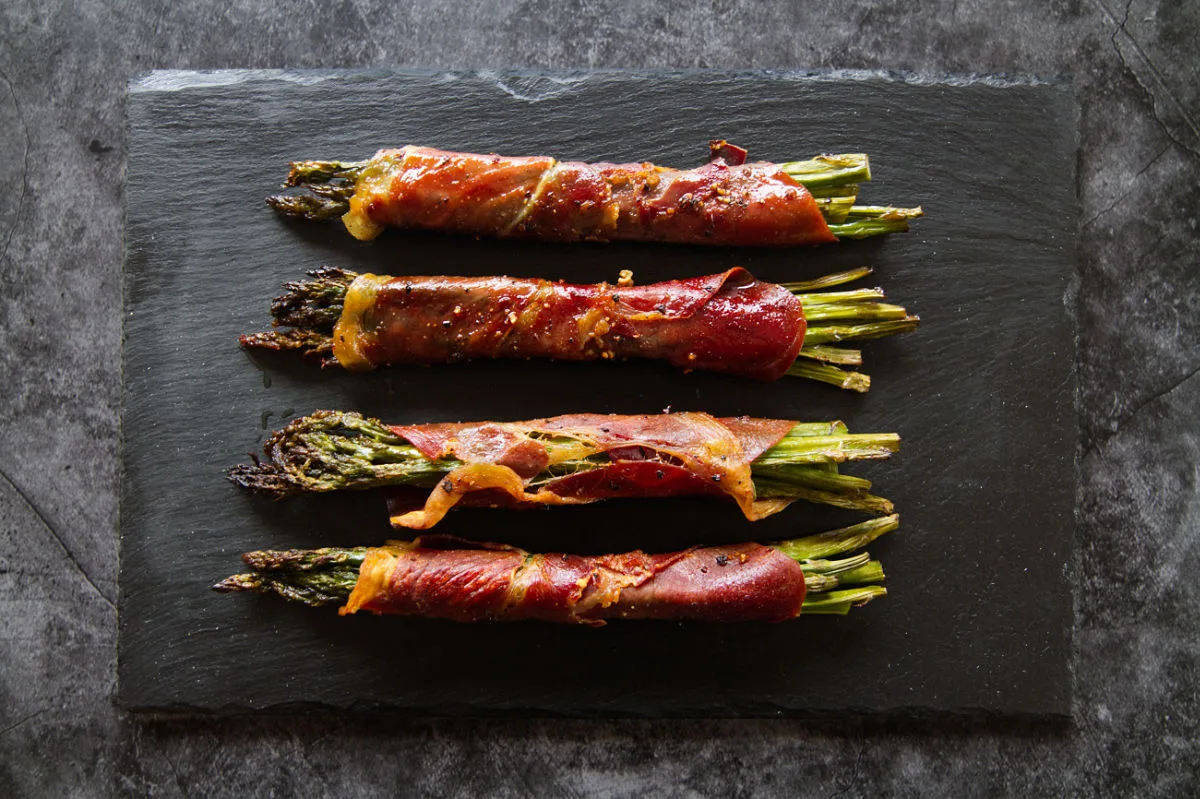
Serrano Ham (Jamón Serrano)
Serrano Ham, also known as jamón serrano in Spain, is a type of dry-cured ham. It is made from the meat of white pigs, “cerdos blancos.” In Spanish, the term “Jamón Serrano” translates to “mountain ham.” The meat is salted and air-dried for several months to develop its unique flavor and texture.
Jamón Serrano has a mild, savory taste and is often enjoyed in tapas dishes, sandwiches, or as a part of various other dishes. Serrano ham is a popular and widely consumed variety of Spanish ham, distinct from the premium jamón ibérico that comes from the black Iberian pigs.
Key characteristics of Serrano Ham include:
- Pig Breed: Serrano ham is made from traditional European pig breeds, such as Duroc, Landrace, or Large White. These pigs are commonly found in many regions and are known for their lean meat.
- Flavor Profile: Compared to the more marbled and intense jamón ibérico, Serrano ham typically has a milder flavor. It offers a savory, slightly salty taste with hints of nuttiness. The flavor is influenced by the pig’s diet, the curing process, and the environment in which it’s produced.
- Curing Process: Serrano ham undergoes a curing process that involves salting and air-drying. It is hung to dry in the mountainous regions of Spain, often at higher altitudes, which contributes to the ham’s unique taste. The duration of the curing process can vary, with longer curing times resulting in more intense flavors.
- Its Use in Cuisine: Serrano ham is a versatile ingredient in Spanish cuisine. It’s commonly served thinly sliced as part of tapas, sandwiches, and salads. Its moderate fat content and balanced flavor make it suitable for various culinary applications.
Availability and Affordability: Serrano ham is more widely available and often more affordable compared to the premium jamón ibérico. It is a staple in Spanish households and restaurants, contributing to a wide range of traditional and modern dishes.
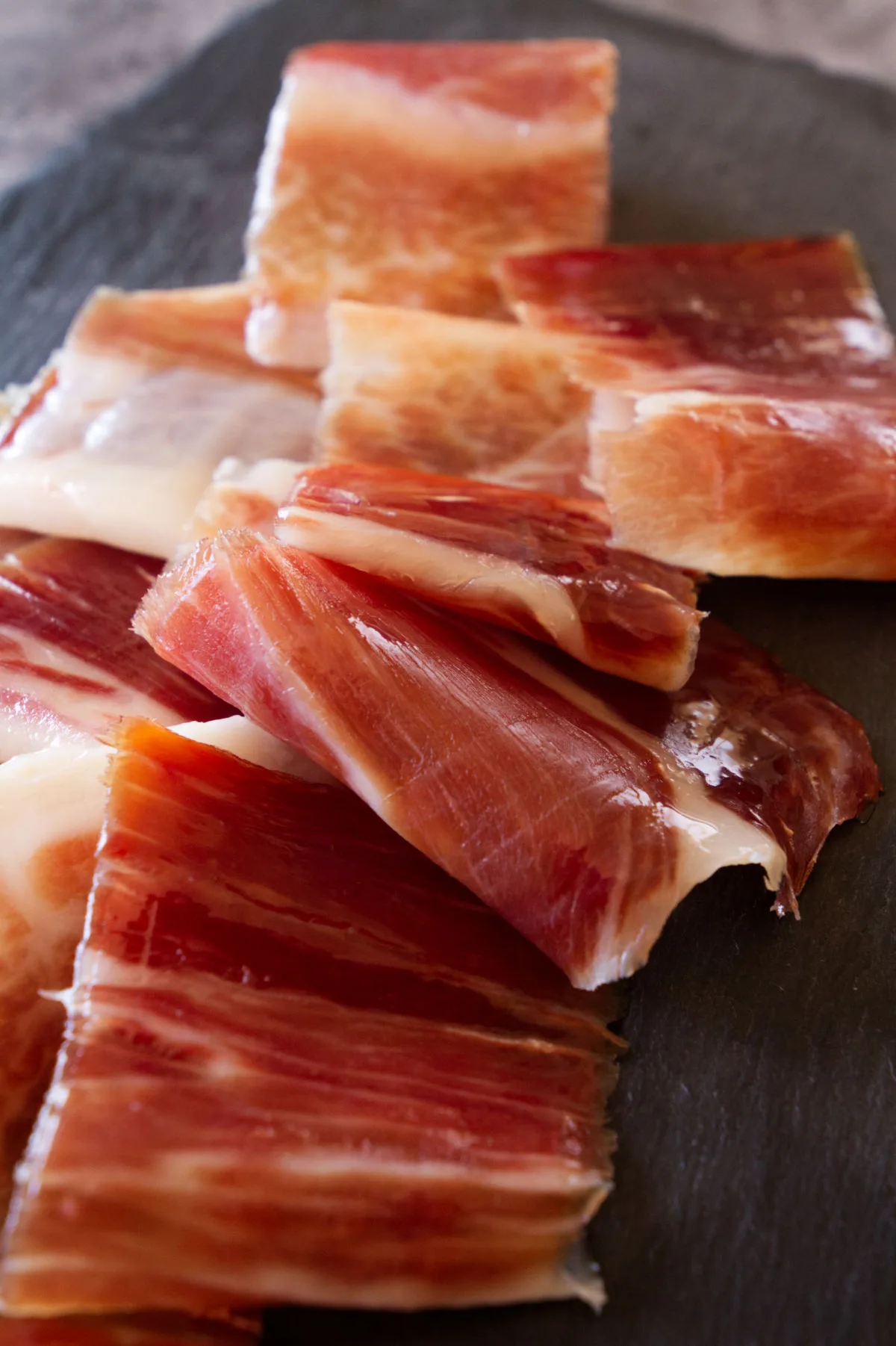
Iberian Ham (Jamón Ibérico)
This variety is made from a specific breed of pig known as the Iberian pig (cerdo Ibérico), which is native to the Iberian Peninsula. These pigs are known for their unique genetics that lead to marbled and flavorful meat.
Jamón Ibérico is renowned for its unique flavor, texture, and the intricate processes involved in its production.
Key characteristics of Iberian Ham (jamón ibérico) include:
- Pig Breed: Jamón Ibérico is made from a specific breed of pig known as the Iberian pig, or “cerdo Ibérico.” These pigs are native to the Iberian Peninsula and are known for their ability to develop intramuscular fat, resulting in marbling that contributes to the ham’s distinct flavor and tenderness.
- Acorn Diet: The highest quality jamón Ibérico, known as “Jamón Ibérico de Bellota,” is made from pigs that are raised in a free-range environment and fed a diet primarily consisting of acorns (bellotas) and other natural resources found in a dehesa, a unique Mediterranean oak forest ecosystem.
- Pig Diet and Lifestyle Grades: After the “Jamón Ibérico de Bellota,” you have “Jamón Ibérico de Recebo” (pigs that eat both acorns and additional feed) and “Jamón Ibérico de Cebo” (pigs raised on commercial feed).
- Curing Process: The curing process for jamón Ibérico involves salting, resting, and air-drying. It can take several years for the ham to reach its full flavor potential, during which time it undergoes a transformation that intensifies its taste and texture.
- Flavor Profile: Depending on the grade and curing time, jamón Ibérico can have a range of flavors, from delicate and nutty to more robust and complex. The marbling of fat throughout the meat contributes to its melt-in-the-mouth texture.
- Cultural Significance: Jamón Ibérico holds cultural and historical importance in Spain (and Portugal). It’s often enjoyed as a centerpiece during celebrations, gatherings, and special occasions — symbolizing tradition, quality, and a connection to the land.
- Price and Rarity: Due to its specialized production, lengthy curing process, and the limited availability of acorn-fed pigs, jamón Ibérico is considered a luxury product and comes with a higher price tag compared to other Spanish hams.
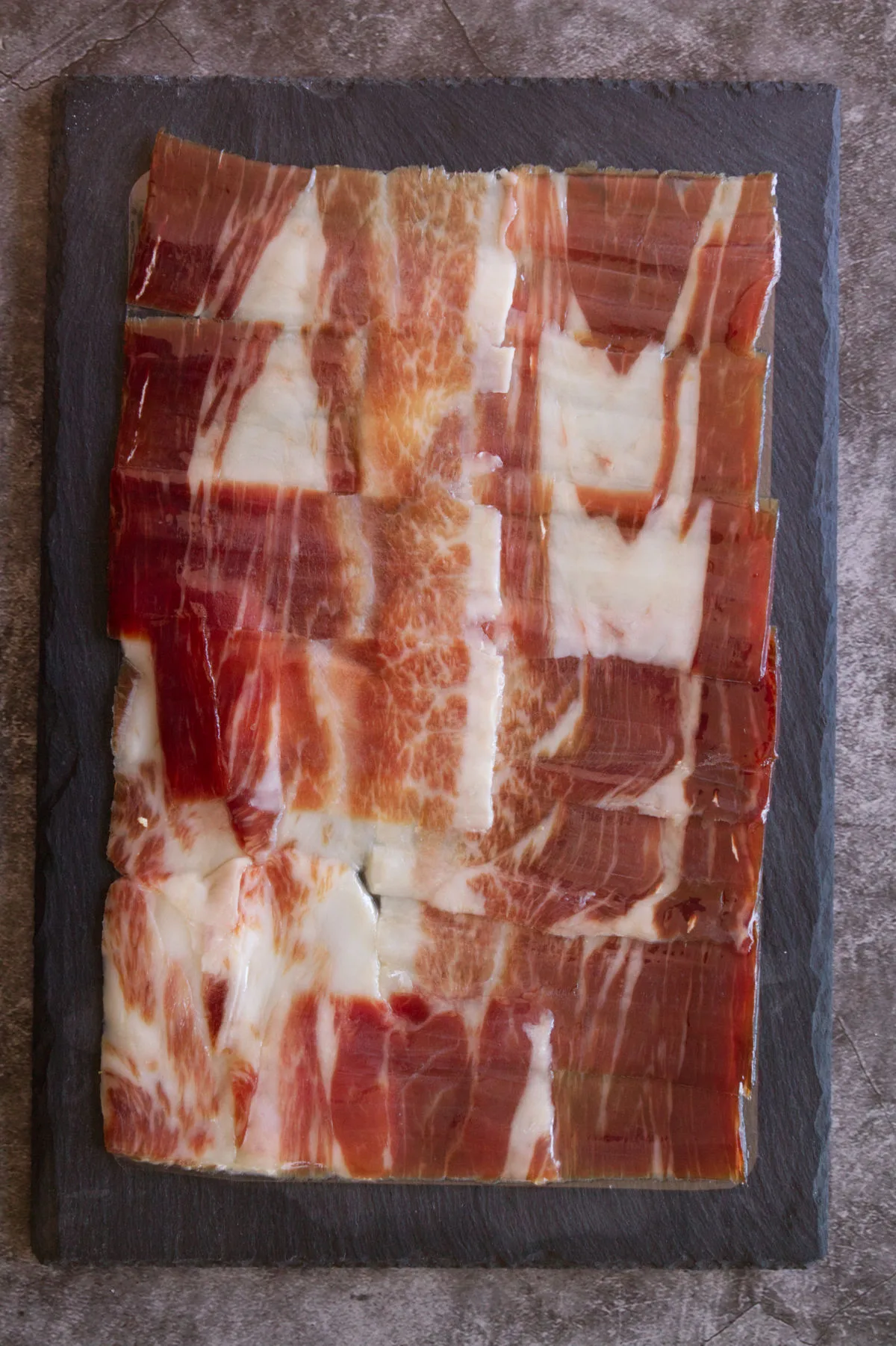
Categories of Jamón Ibérico
There are different categories and qualities of Jamón Ibérico based on factors like the pig’s breed, diet, and curing process. The two main types are:
Jamón Ibérico de Bellota:
This is the highest quality and most sought-after type of Jamón Ibérico. The pigs are raised in the traditional “dehesa” system, a type of pastureland with oak and cork trees.
During the “montanera” period (usually October to February), the pigs are allowed to roam freely and feed primarily on acorns (bellotas) and natural resources found in the dehesa. This diet gives the ham a rich, nutty flavor and a marbled texture.
Jamón Ibérico de Bellota is often labeled with different designations, such as “100% Ibérico de Bellota” (indicating purebred Iberian pigs) and “75% Ibérico de Bellota” (indicating a cross between Iberian and other pig breeds).
Jamón Ibérico de Cebo de Campo:
This type of Jamón Ibérico comes from pigs that are also raised in the dehesa but are fed a combination of acorns and other supplementary feeds.
While they do not enjoy the same diet quality as bellota pigs, they still have access to an open-air environment that allows them to move and forage. This type is considered a step below the premium quality of Jamón Ibérico de Bellota.
It’s important to note that there are additional designations and classifications, including “Jamón Ibérico de Cebo,” which refers to ham from pigs raised on commercial feed without access to the open range or acorns. This type is generally considered to be of lower quality compared to the other two mentioned.
Overall, jamón Ibérico is celebrated for its extraordinary taste and the artisanal craftsmanship involved in its creation. It’s a testament to the harmony between nature, culture, and culinary expertise in the Iberian Peninsula.
Where Does Iberian Ham Come From?
Iberian Ham is made from a specific breed of pig that lives primarily in the central and southwestern region of the Iberian Peninsula, which includes both Spain and Portugal. In Spain, the black Iberian pig is typically found in the provinces of Badajoz, Córdoba, Cáceres, Huelva, Ciudad Real, Salamanca, and Seville.
In Portugal, the central and southern regions have an abundance of this breed, especially in the Alentejo region.
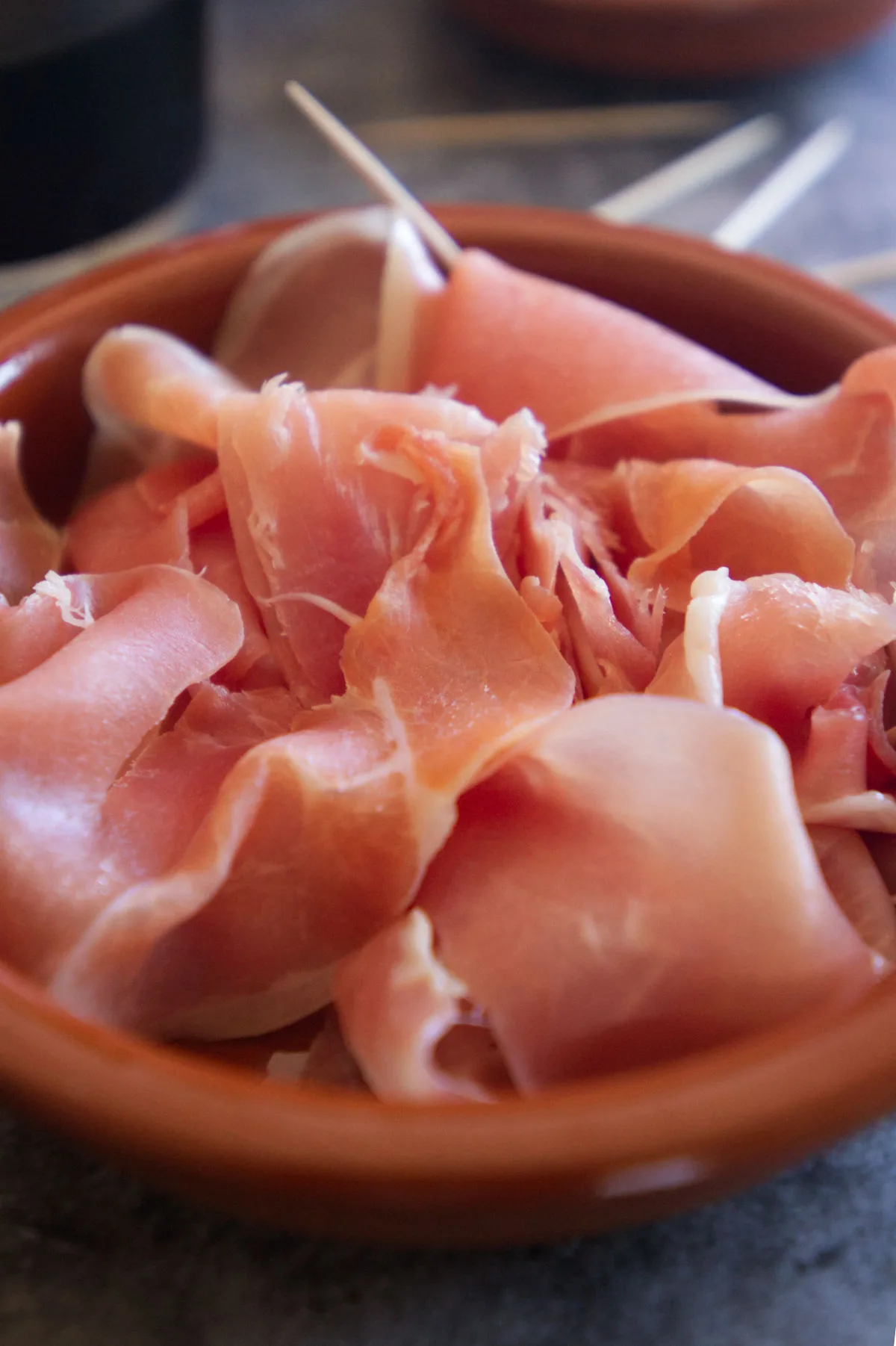
Gran Reserva Ham (Jamón Gran Reserva)
Gran Reserva ham signifies a premium and highly regarded product. It is Spanish ham (either Iberian ham or Serrano ham) that is aged for an extended period, resulting in an even richer and more intense flavor profile.
Gran Reserva is not a standardized classification like Jamón Ibérico or Jamón Serrano. It is more of a designation used by producers to indicate that a specific ham has undergone a prolonged aging process. As with other types of Spanish ham, the quality and flavor of Gran Reserva ham can vary based on factors such as the pig’s breed, diet, and the artisanal techniques used during production.
Similar to aged wines or cheeses, the aging process of Gran Reserva ham allows the meat to develop complex flavors and textures that set it apart from other hams.
Key characteristics of Gran Reserva ham include:
- Aging Process: Gran Reserva ham undergoes a significantly longer aging process compared to other hams. It is cured and aged for a minimum of 18 months up to several years, to develop its distinctive taste.
- Flavor Development: The extended aging process contributes to the concentration of flavors in the ham. It develops a deep, nuanced taste that can range from nutty and savory to slightly sweet, with hints of earthiness and umami.
- Texture: The aging process also affects the texture. It becomes more tender and melts in the mouth, thanks to the breakdown of connective tissues and the redistribution of fats.
- Marbling: The prolonged aging enhances the marbling of fat within the ham, resulting in a well-distributed, fine network of fat that contributes to the ham’s succulence and flavor.
- Color: The color of Gran Reserva Ham becomes darker as it ages, transitioning from the initial bright red to a deeper, richer hue.
- Culinary Use: Due to its intense flavor and tenderness, Gran Reserva ham is often enjoyed on its own, thinly sliced, as a centerpiece of charcuterie platters or tapas. When used in recipes, it is used to elevate dishes, adding depth of flavor and complexity.
- Price and Rarity: Gran Reserva ham is considered a luxury product due to its extended aging process, which requires more time and resources. As a result, it is typically more expensive than other types of Spanish ham.
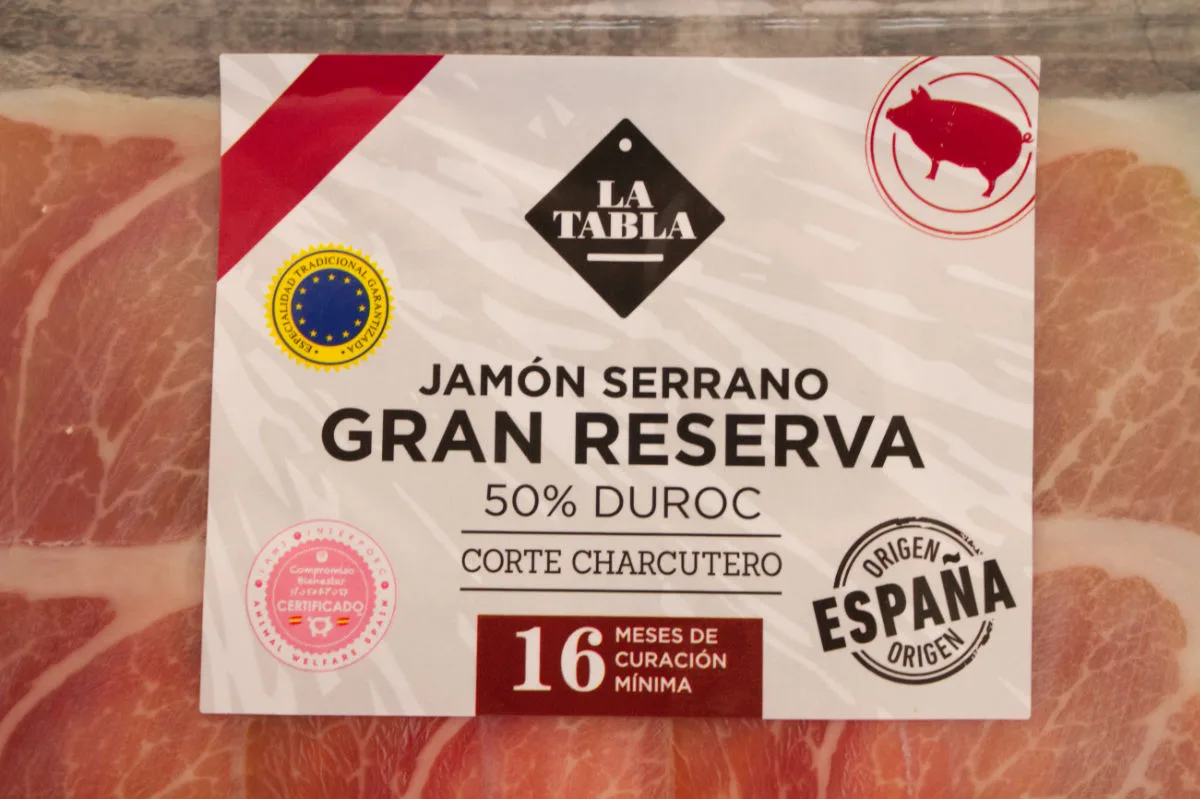
Cultural Significance of Spanish Ham
The cultural significance of Spanish ham, especially Jamón Ibérico, is deeply rooted in Spain’s gastronomic history and social traditions. It holds a special place in Spanish culture and is a symbol of Spanish identity where its consumption is more than just a culinary experience, it’s a centuries-old tradition that Spaniards cherish.
- Historical Roots: The methods of curing and preserving ham have been passed down through generations, contributing to a sense of tradition and heritage.
- Symbol of Identity: Spanish ham is often considered a symbol of Spanish identity and pride. It’s recognized both nationally and internationally as a representative of Spanish cuisine and culture.
- Social Gatherings: Spanish ham is frequently enjoyed during social gatherings, celebrations, and family events. Sharing a plate of thinly sliced ham is a common practice that brings people together, fostering social connections.
- Respect for Ingredients: The careful and patient process of producing Spanish ham reflects a cultural value of respecting ingredients and traditional methods of preparation. This appreciation for quality and craftsmanship is an integral part of Spanish culinary culture.
- Festivals and Fairs: Many Spanish towns and regions host festivals and fairs dedicated to ham. These events celebrate the art of ham production, featuring tastings, carving, competitions, and cultural performances.
- Art of Carving: The skillful carving and presentation of Spanish ham are considered an art form. Master carvers (called ‘Cortador’ or ‘Cortadora’ in Spain) are highly respected, and their expertise is showcased at events and in restaurants.
- Gifts and Hospitality: Spanish ham is often given as a gift or offered as a sign of hospitality. It’s a gesture of generosity and warmth.
- Economic Impact: The production of Spanish ham contributes significantly to the economy, providing livelihoods for farmers, producers, and various other professionals involved in the industry.
- International Recognition: Spanish ham, particularly Jamón Ibérico, has gained international acclaim. It’s sought after by food enthusiasts and chefs worldwide, solidifying its cultural significance beyond Spain’s borders.
Best Ways to Enjoy Spanish Ham
Serrano ham is enjoyed either on its own as a tapas or in recipes such as Huevos estrellados (Madrid-style eggs and potatoes), Burrata with Serrano Ham and Roasted Peppers, or Roasted asparagus wrapped in Serrano ham. Perhaps the most common recipe for Serrano ham is the humble bocadillo (a sandwich using a baguette). This Jamón Serrano and Manchego Cheese Bocadillo recipe is a classic Spanish favorite and you’ll find it all over Spain.
Jamón Ibérico is most commonly served as a tapas and is rarely used in recipes, mainly due to its prized status and price. If you find Jamón Ibérico in recipes, it will be used sparingly.
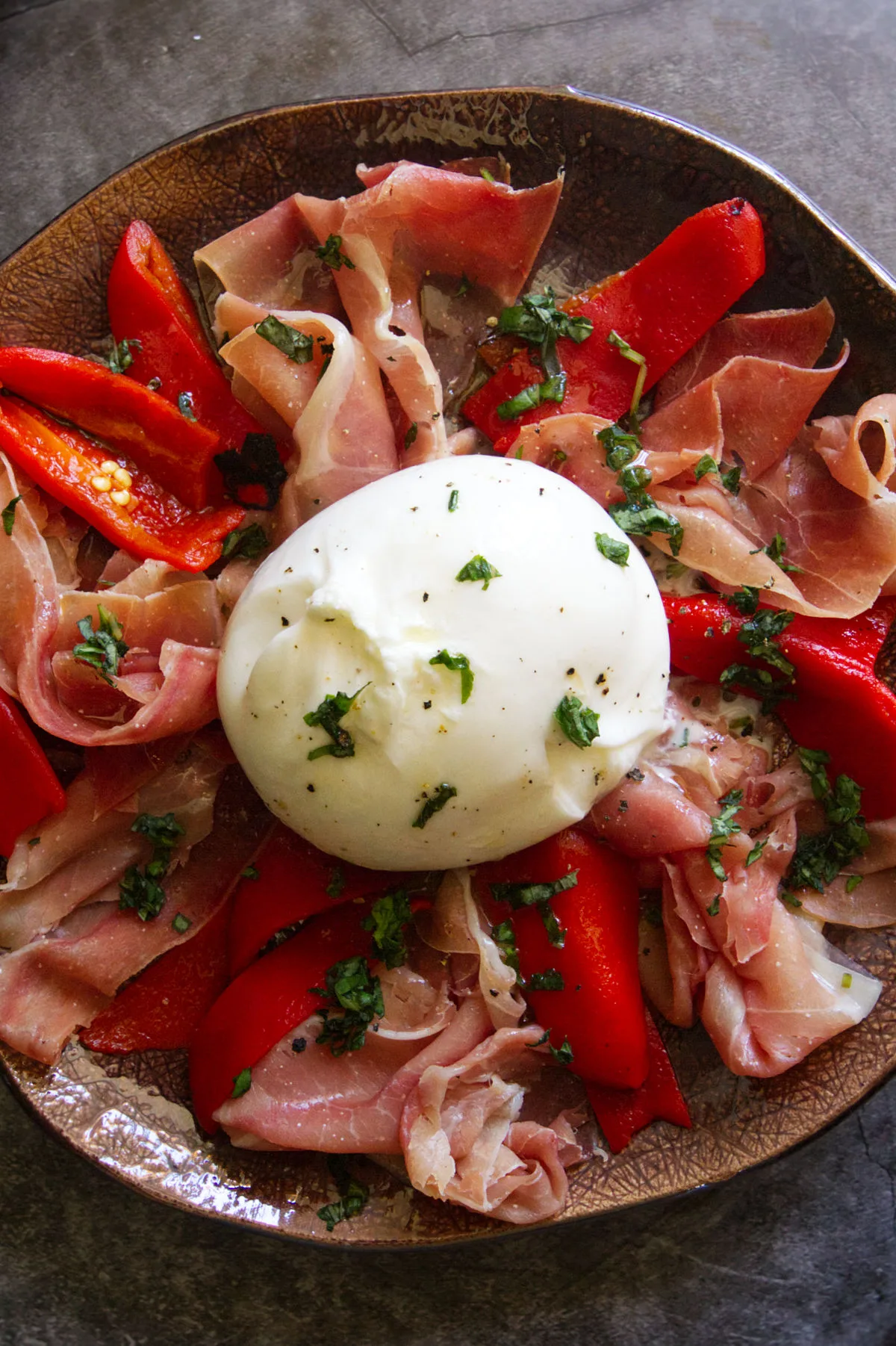
Health Benefits and Nutrition Facts Of Spanish Ham?
For those who love Spanish ham, we have some great news. Spanish ham, particularly Jamón Ibérico, is not only a gastronomic delicacy but also offers several potential health benefits when consumed in moderation as part of a balanced diet.
Nutritional Facts (per 3.5oz/100g serving)
(Note: Nutritional content can vary based on factors like the pig’s diet, curing process, and fat content.)
- Calories: Approximately 300-350 kcal
- Protein: Around 30-35g
- Cholesterol: Approximately 50-70mg
- Total Fat: About 20-25g
- Saturated Fat: Varies, but usually lower than other cured meats
- Monounsaturated Fat: Significant amount, including heart-healthy oleic acid
- Vitamins and Minerals:
- B Vitamins (B1, B6, B12): Important for energy metabolism and nervous system health
- Zinc: Supports immune function, wound healing, and cell growth
- Selenium: Acts as an antioxidant and supports thyroid function
- Phosphorus: Vital for bone health and various physiological processes
Health benefits of Spanish ham
- Rich in Protein: Spanish ham is a good source of high-quality protein, which is essential for muscle maintenance and overall body function.
- Healthy Fats: Jamón Ibérico, in particular, contains higher proportions of unsaturated fats, including oleic acid, which is also found in the extra-nutritious olive oil. These healthy fats are associated with improved heart health and can contribute to a balanced diet.
- Monounsaturated Fats: The presence of monounsaturated fats in Spanish ham can help improve cholesterol levels by increasing HDL (“good”) cholesterol and reducing LDL (“bad”) cholesterol levels.
- Rich in Vitamins and Minerals: As noted above, Spanish ham is a source of various vitamins and minerals, including B vitamins (such as B1, B6, and B12), zinc, selenium, and phosphorus. These nutrients play important roles in energy metabolism, immune function, and bone health.
- Source of Antioxidants: The natural curing and aging process of Spanish ham can result in the further development of antioxidant properties, which have health benefits, including cell protection and reduced oxidative stress.
- Potential Cardiovascular Benefits: The consumption of moderate amounts of monounsaturated fats from Spanish ham, as part of a balanced diet, has been linked to improved heart health and reduced risk of cardiovascular diseases.
It’s important to note that while Spanish ham does offer potential health benefits, it’s also high in salt and calories. Therefore, moderation is key to avoiding excessive sodium intake and overconsumption of calories. A recommended daily serving is between 50-100 grams maximum.
Individuals with specific dietary restrictions or health problems should consult their healthcare provider before making Spanish ham a regular part of their diet.
Where to buy Spanish Ham
USA
Good quality Spanish Serrano ham and Iberian ham can be purchased from specialty Spanish goods stores and at some large supermarket chains (Walmart, Costco).
- Expect to pay around USD $12-15 for a 3oz. packet of Serrano ham in the supermarket.
- Expect to pay around USD $15-50 per ounce for Jamon Ibérico, with acorn-fed 100% sliced Ibérico (Bellota) being at the higher price range.
Another good option is to purchase imported Spanish Serrano ham online and there are plenty of online Spanish ham stores available to choose from, with many offering free delivery for larger purchases.
Here are a few reputable online stores offering Spanish Serrano ham:
- La Española Meats, Inc.
- Enrique Tomás
- Ibérico Club
Canada
Most large supermarkets will stock at least one variety of Serrano ham and possibly Jamon Ibérico. Walmart has a 50g packet of Serrano ham for $3. Spanish Pig has an excellent selection of Spanish hams and other specialty items you might be looking for.
Europe
Most large supermarkets and specialty Spanish food stores will stock a good selection of Spanish ham. Lidl offers a good range of Spanish ham in most countries, including Spanish Serrano ham, Jamon Ibérico, and Gran Reserva products. If you’re looking to purchase online, Jamonariam delivers to most of Europe, although shipping prices vary by country so check first. Enrique Tomás has free shipping to some of Europe but there’s a minimum spend.
UK
Serrano ham and Iberian ham are relatively easy to find in the UK and a majority of high-street supermarket chains will sell Serrano ham in 100g packets. Tesco offers 11-month cured Serrano ham for around £1.99 per 100g. You can buy Ibérico and Serrano from Ibérico Club UK, and they offer free shipping.
Australia
Head to your specialty butcher or Spanish specialty food stores to source the best Spanish ham. Supermarkets such as Coles, ALDI, and Woolworths also stock Serrano ham, and you can expect to pay at least $50 per kilo for 12-month-old aged Spanish Jamón Serrano. Jamon Ibérico can be a little more tricky to find, but online specialty stores like Spanish Deli have some quality products.
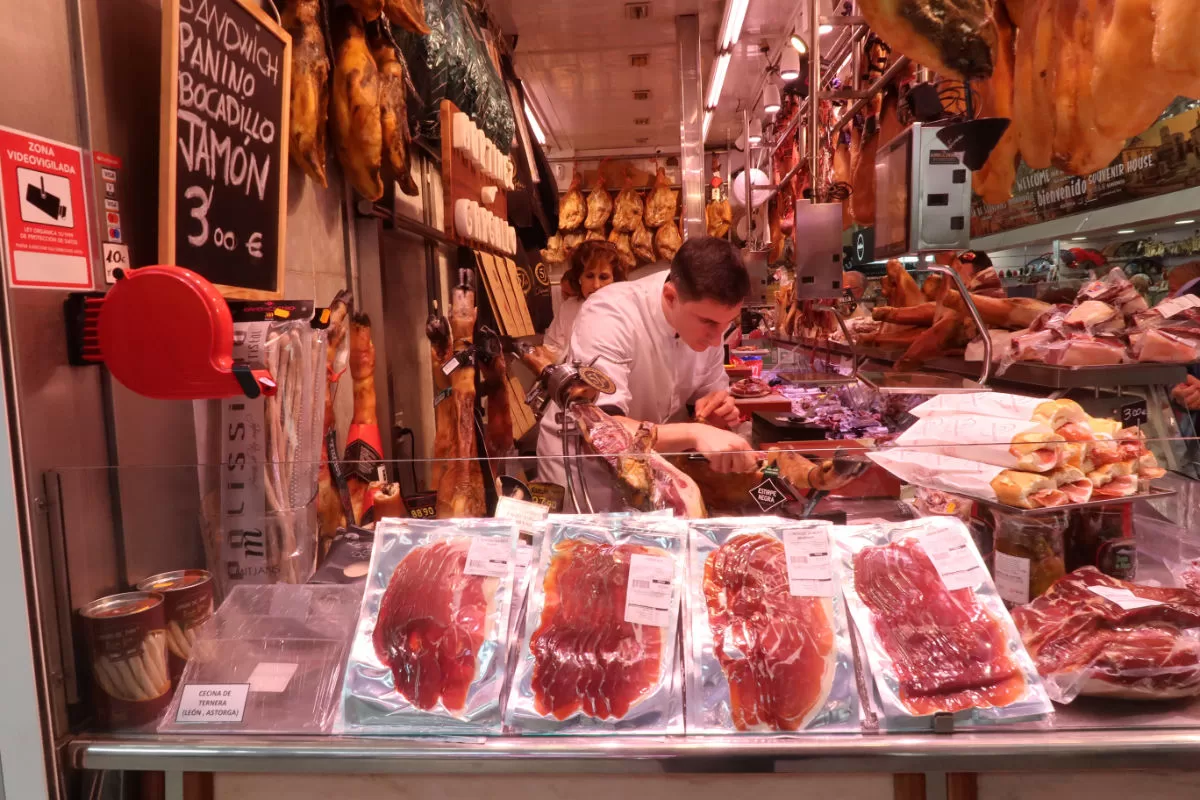
Spanish Ham FAQs
What’s the difference between Jamón Serrano and Jamón Ibérico?
Jamón Serrano comes from white pigs and is more widely available, while Jamón Ibérico comes from a specific breed of Ibérian pigs and is known for its richer flavor and higher price due to the pigs’ unique diet and breed.
Is all Iberian pork acorn-fed?
No. In fact, only a small proportion (between 5-15%) of Iberian ham is made with Ibérian pigs that are exclusively fed on acorns.
What do they feed Ibérico pigs?
It is common practice to allow Ibérian pigs to roam and they will eat from the meadows and grasslands where they live. Ibérian pigs In the summer months, pigs will graze on grass, mushrooms, bugs, slugs, and local herbs such as rosemary and thyme. In the winter months, Ibérian pigs will eat acorns and other grasses.
Is Ibérico ham healthy?
Yes. Studies have found that Jamon Ibérico is not only delicious but also rich in vitamins and essential amino acids with 3.5oz / 100g providing 24% of your recommended daily intake of vitamins.
Is Ibérico ham bad for cholesterol?
No. It’s been shown that moderate consumption (between 2-3.5oz / 50-100g per day) of good quality Jamon Ibérico helps maintain adequate levels of cholesterol and can help prevent cardiovascular disease.

0 Comments